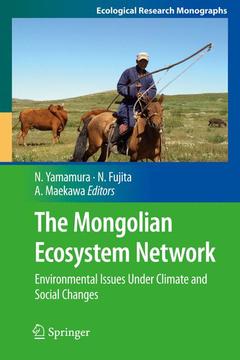Description
The Mongolian Ecosystem Network, 2013
Environmental Issues Under Climate and Social Changes
Ecological Research Monographs Series
Language: English
Subjects for The Mongolian Ecosystem Network:
Publication date: 10-2014
320 p. · 15.5x23.5 cm · Paperback
Publication date: 09-2012
320 p. · 15.5x23.5 cm · Paperback
Description
/li>Contents
/li>Comment
/li>
The aim of this book is to describe what is currently occurring in the Mongolian grasslands, to analyze how various factors creating environmental problems interact, and to suggest solutions for sustainable management of the grasslands. The book has three parts. Part I is an introduction, explaining the key concept of an ecosystem network and providing background information on the general features of Mongolian nomadic pastoralism as well as distribution of vegetation in Mongolian grasslands. Part II describes the effects of natural environmental factors and nomadic activities on grassland conditions. Water dynamics that maintain the grassland system are analyzed in a steppe region with shrubs and in a forest-steppe region with trees. Part III describes the effects of economic and social factors on land-use and the livelihood of herders. As nomadic people moved closer to large cities for economic advantage in the 1990s, degradation of pastures by overgrazing resulted. Finally, the impacts of global warming and globalization on the Mongolian society and ecosystem are examined. This book analyzes environmental problems in Mongolian grasslands, but the contents contribute to consideration of environmental problems and sustainable pasture use in grassland areas worldwide.
These books may interest you

Grasslands and Climate Change 99.06 €



